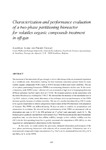Mostrar o rexistro simple do ítem
Characterization and performance evaluation of a two-phase partitioning bioreactor for volatiles organic compounds treatment in off-gas
| dc.contributor.author | Aldric, Jean Marc | es_ES |
| dc.contributor.author | Thonart, Philippe | es_ES |
| dc.date.accessioned | 2014-10-01T10:17:02Z | |
| dc.date.available | 2014-10-01T10:17:02Z | |
| dc.date.issued | 2007 | es_ES |
| dc.identifier.citation | Biotechniques for Air Pollution Control II, 2007: 495-504. ISBN: 978-84-9749-258-4 | es_ES |
| dc.identifier.isbn | 978-84-9749-258-4 | es_ES |
| dc.identifier.uri | http://hdl.handle.net/2183/12846 | |
| dc.description.abstract | [Abstract] The treatment of the industrials off-gas strongly evolves with change of the environmental legislation on a worldwide scale. Biotechnics existing for their treatment sometimes present limits for some volatile organic compounds (VOC) such as BTEX because of their poor water solubility. The use of two phase-partitioning bioreactors (TPPB) is an interesting alternative in this case. In this work, a laboratory scale TPPB (water / silicone oil) was monitored at high level of Isopropropylbenzene (IPB) air pollution (7g/Nm3) and a flow of 1 VVM. We focused ourselves on the inoculation with the strain Rhodococcus erythropolis T 902.1. We showed that the increase of the inoculums size to 5 g DM/l. induces a better initial abatement of the pollutant, however performances of the TPPB decrease quickly because of cellular mortality. The use of a smaller inoculum (0,2g DM /l) seems to be a good compromise to observe progressive improvement of the IPB abatement with adaptation of biomass. The TPPB was followed during 38 days in order to confirm its potentialities and characterise its evolution. We showed that the performances of the TPPB are maintained with an elimination rate near to 63 % for IPB polluted air (7 g/Nm3) and punctually reach 92 %. The biomass grows gradually and stabilizes itself around 10 g/l. With fluorescent double stain Rhodamine/ propidium iode, we also shown that cellular viability strongly evolve: cellular viability was low (30 %) in the first operating hours but is quickly increased after adaptation to IPB (80%); we also suggested an endorespiration phenomenon in the bioreactor. In this work, we could confirm the previously estimated elimination performances of the two- phase partitioning bioreactor with silicone-oil as second phase. Elimination rate of a monoaromatic compound at high concentration (7 g / Nm3) can be maintained between 240 g /m3.h and 360 g /m3.h. in the TPPB. | es_ES |
| dc.language.iso | eng | es_ES |
| dc.publisher | Universidade da Coruña | es_ES |
| dc.title | Characterization and performance evaluation of a two-phase partitioning bioreactor for volatiles organic compounds treatment in off-gas | es_ES |
| dc.type | info:eu-repo/semantics/conferenceObject | es_ES |
| dc.rights.access | info:eu-repo/semantics/openAccess | es_ES |






